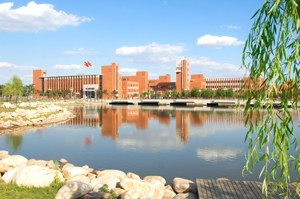Shenyang University of Technology (SUT) is an engineering-centered, application-oriented and multidisciplinary university. In the university, a variety of disciplines are offered, including engineering, science, economics, management, humanities, law, philosophy, and arts. The university was originally founded in 1949 and named as Shenyang Institute of Mechanical and Electrical Engineering supervised by the former National Ministry of Machinery and Industry. In 1985 it was renamed as Shenyang University of Technology (SUT). Since 1998 the university has been jointly sponsored by Liaoning Province.


SUT currently consists of four parts: the Central Campus, Xingshun Campus, the National Science and University Science Park, and Liaoyang Campus. The Central Campus is the main campus which is located in the Shenyang Economic and Technological Development Zone, a cluster area of equipment manufacturing industries.
In total, SUT covers an area of 1,589,900㎡, with a construction area of 742,700㎡. In SUT, there are 20 schools, 2 teaching departments and 2 engineering training centers. Moreover, 55 undergraduate programs and 19 vocational programs are also offered in the university. Currently, SUT is home to about 32,000 students, including 28,370 undergraduate and diploma students, more than 3,800 graduate students and 214 overseas students.


Up to now the university faculty consists of 1,313 members, including 2 academicians of Chinese Academy of Engineering, 186 professors, 402 associate professors, 666 lecturers, 165 Ph.D. supervisors, 516 master supervisors, and 78 young and middle-aged academic pacesetters in their chosen field of learning. Teachers with master’s and doctor’s degrees account for 85.8 percent of all the faculty members, and 35.3 percent of them are Ph.D. holders. Professors and associate professors comprise 44.8 percent of the full-time teachers. Among the faculty members there are winners of National May 1 Labor Medal and State Science and Technology Award; 15 teachers enjoy Special Government Allowances of the State Council; 2 teachers have been selected as members of National Key Talent Project, another one as Climbing Scholars of Liaoning Institutions of Higher Education, and 64 as members of Liaoning Key Talent Project (Hundred and Thousand Program levels). In addition, there are 8 provincial distinguished professors, 6 provincial excellent experts, and 6 winners of Young Teacher Award by Fok Ying-Tung Education Foundation.
The university is authorized to confer the Bachelor’s, Master’s, and Doctor’s degrees. It has 1 national key secondary discipline (Electrical Machines and Apparatus), 4 provincial first-class disciplines supported by the project of building top class universities in Liaoning Province (Electrical Engineering, Material Science and Engineering, Mechanical Engineering, Instrument Science and Technology) and 4 postdoctoral research stations of these disciplines, 5 Ph.D. programs in primary disciplines, 20 Master programs in primary disciplines, and 5 professional degrees: Master of Engineering, Master of Accounting, Master of Business Administration, Master of Engineering Management, and Master of Finance, among which the program of Master of Engineering covers a series of 13 sub-disciplines.
Facing the world with an open mind, SUT has established intercollegiate partnerships with 49 universities and colleges in the United States, Russia, Japan, Germany, the United Kingdom, Australia, Korea, and Finland, etc. It has been recruiting overseas students since 1995. Since 2001, the university has launched international joint education programs with Griffith University in Australia and Benedictine University in the United States in cultivating undergraduates and postgraduates. Over 1,700 undergraduate students have studied or are going to study abroad in Australia, and around 300 MBA students have graduated from the joint program with Benedictine University.
Upholding the motto ofSelf-improvement and Sincere Actand carrying forward the spirit ofHard Work and Self-discipline, SUT with its historical heritage and expectations for the future, is forging ahead toward its goal of becoming a nationally renowned university with unique industrial characteristics.